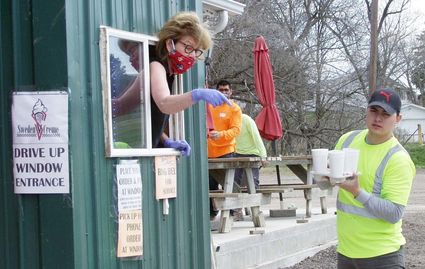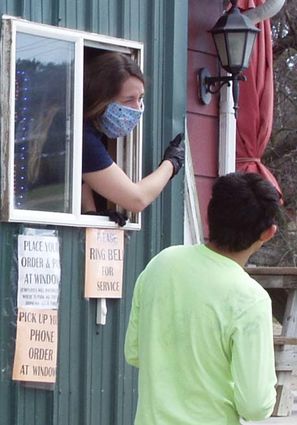Social Distancing, Isolation or Quarantine
April 16, 2020

COVID-19 directives have closed the sit down restaurant business in Kansas and Nebraska, so most have devised some type of carry-out service. Above, a Sweden Creme employee leans out a new drive-up window.
We are in a time when "social distancing" should be a way of life and not merely a "buzz word." Though it may feel like the term is new, the concept is quite old. Consider those with leprosy in Biblical times. As long as they were ill, they were to live apart from society and call "leper, leper" if they came near anyone.
Today "social distancing" means to leave home only for essentials and maintain six feet of distance between any others that may be where it is essential for you to be. It means to avoid being near anyone who doesn't live with you. It means no large or small gatherings in public or private settings.
Isolation is another term. It means that someone who is ill stays away from all others. The diagnosed person uses a separate room, separate dishes, and, ideally, a separate bathroom. Isolation keeps those who are ill away from those who are healthy.
Quarantine is yet another term. It means those who might have been exposed stay away from others. In strict terms, it means not leaving the home. With Covid-19, the minimum quarantine (or self-quarantine) is 14 days.
Has quarantine been used in our vicinity? Yes! In a quick survey of historical newspapers of the area, the word "quarantine" is used more than 1,000 times. Quarantines were put in place for infantile paralysis (polio), mumps, small pox, scarlet fever, scarlatina, diphtheria and whooping cough. (To be fair, horses, mules and cattle were also subject to quarantine – but are not the focus of this article.)
The Oct. 1, 1930 issue of the Jewell Rural High School Spotlight notes schools were closed and the "whole county quarantined" because of infantile paralysis. The quarantine was to last from "Friday, Sept.5, to Monday, Sept. 15, at 8 o'clock a.m."
In November of that year (1930), the Spotlight noted that "Jamestown hasn't played many (football) games this season as they have been quarantined on account of infantile paralysis." But good news was reported also. The Randall Rural Record noted in 1937, Everett McMillan who had infantile paralysis was "out of quarantine."
The Belleville Telescope reported in their Dec. 2, 1937 edition "The Formoso schools have been closed on account of an outbreak of scarlet fever. Four cases were quarantined." In Burr Oak in April of 1910 the County Health officer quarantined several families with scarlet fever because "precaution is better than funerals."

When someone in a family had any of the listed diseases, the family would be quarantined to prevent the spread of the disease. The Randall Enterprise reported on Dec. 23, 1906 that "Bill Easter's are quarantined for scarlet fever. Little Violet is the one who is sick." Likewise, in Formoso according to the New Era May 21st issue of 1936 "Mrs. Riley Jones has scarlet fever, and they are all quarantined."
Scarlet fever was often the culprit when individuals and families were quarantined. When Harold Ebright of Formoso was quarantined with it in January on 1935, his parents, Mr. and Mrs. S. H. Ebright of Belleville went to "take charge of the filling station." Nancy Spohn Headrick of Jewell grew up in Superior. She recalls, as an early elementary student, her family being quarantined with scarlet fever and then whooping cough. They were "out on the farm and didn't go anywhere."
Nancy Headrick's sister-in-law, Esther Phillips Headrick, grew up in Norton but is now again a resident of Superior. She recalls three quarantines. The first was when she had the measles and the county health officer came and put the "Quarantined" sign on the family's front door. The second time she was quarantined was when she was in the seventh grade and had polio. She recalls her friends coming to her window on their way to and from school. That quarantine lasted some weeks.
The third time Esther was involved with a quarantine was in mid-November of 1949 when her 6-week old son, the late Steve Headrick, had whooping cough. He had caught the disease from a cousin before the family realized she was ill. Dr. Mason cared for the baby and he survived. Phyllis Warren Lange of Mankato, a cousin, remembers the little baby having whooping cough and that "they almost lost him."

Families and individuals were not the only ones quarantined. In November of 1905, Formoso's New Era newspaper reported "The city of Ruebens is quarantined on account of scarlet fever." The Burr Oak Herald warned of small pox in Guide Rock in the Feb.1, 1900 issue. "a barber brought it from Oklahoma City." "Schools have been dismissed and the town is quarantined."
The reasons for quarantine were varied. The Sherman Loomis family of Topeka were quarantined with mumps it was reported in the Feb. 18, 1937 issue of the Formoso New Era. The Randall Rural Record noted on April 1, 1931, Geraldine Magee and Carl Doolittle both were quarantined with "small pox."
Small pox, with its fatal possibilities was ominous for families and communities. In the Monitor's June 22, 1905 issue readers were informed "Teague Marr's family is quarantined with smallpox." Also "Dr. Hittner disinfected the home of Ben Britain Monday and took down the quarantine. The entire family has had the smallpox and have been quarantined for over two months." was an item in the Esbon Times in May 31, 1906.
Long quarantines were not uncommon. It was reported by Formoso's New Era the Ray Hodgell Family of Topeka were quarantined from "before Christmas" until mid-March with the mumps.
Professionally, as a nurse, Linda Hutchcraft Woerner, recalls making emergency plans for quarantines but thankfully never having to carry them out.
Let us hope our social distancing and staying at home keep us safe without rigid quarantines.







Reader Comments(0)